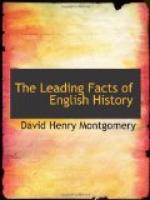first or chief. [4] The existence of the Cabinet depends
on custom, not law. Its three essential characteristics
are generally considered to be: (1) Practical
unanimity of party; (2) Practical unity of action under
the leadership of the Prime Minister; (3) Collective
responsibility to the party in the House of Commons
which represents the political majority of the nation.
Its members are never OFFICIALLY made known to the
public, nor its proceedings recorded. Its meetings,
which take place at irregular intervals, according
to pressure of business, are entirely secret, and
the sovereign is never present. As the Cabinet
agrees in its composition with the majority of the
House of Commons, it follows that if the Commons are
Conservative, the Cabinet will be so likewise; and
if Liberal, the reverse. Theoretically, the
sovereign chooses the Cabinet; but practically the
selection is now always made by the Prime Minister.
If at any time the Prime Minister, with his Cabinet,
finds that his political policy no longer agrees with
that of the House of Commons, he and the other members
of the Cabinet resign, and the sovereign chooses a
new Prime Minister from the opposite party, who forms
a new Cabinet in harmony with himself and the Commons.
If, however, the Prime Minister has good reason for
believing that a different House of Commons would support
him, the sovereign may, by his advice, dissolve Parliament.
A new election then takes place, and according to
the political character of the members returned, the
Cabinet remains in or goes out of power. The
Cabinet, or Government, now invariably includes the
following officers:
1. The First Lord of the Treasury (usually
the Prime Minister).
2. The Lord Chancellor.
3. The Lord President of the Council.
4. The Lord Privy Seal.
5. The Chancellor of the Exchequer.
6. The Secretary of State for Home Affairs.
7. The Secretary of State for Foreign Affairs.
8. The Secretary of State for the Colonies.
9. The Secretary of State for India.
10. The Secretary of State for War.
11. The First Lord of the Admiralty.
In addition, a certain number of other officers are
frequently included, making the whole number about
twelve or fifteen.
535. The “Pretender”; “The
Fifteen” (1715); the Septennial Act (1716).
The fact that George I exclusively favored the Whigs
exasperated the opposite, or Tory, party. The
Jacobites or extreme members of that party (S495),
in Scotland, with the secret aid of many in England,
now rose, in the hope of placing on the throne James
Edward Stuart, the son of James II. He was called
the “Chevalier"[1] by his friends, but the “Pretender”
by his enemies (SS490, 491, 512). The insurrection
was led by John, Earl of Mar, who, from his frequent
change of politics, had got the nickname of “Bobbing
John.” Mar encountered the royal forces
at Sheriffmuir, in Perthsire, Scotland (1715), where
an indecisive battle was fought, which the old ballad
thus describes:




